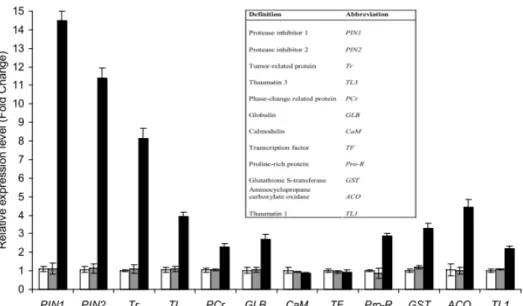Armillaria mellea, the causal agent of grapevine root rot, induces a set of defense genes in grapevine roots.
Michele Perazzolli1, Federica Bampi1, Silvia Faccin1, Mirko Moser1, Federica De Luca1, Anna Maria Ciccotti1, Riccardo Velasco1, Cesare Gessler2, Ilaria Pertot1 and Claudio Moser1
1 Genomics and Biology of Fruit Crops Department, IASMA Research and Innovation Centre, Fondazione Edmund Mach, San Michele all'Adige, (TN), Italy
2 Institute of Plant Science, ETH Zürich, Switzerland
e-mail: [email protected]
Grapevine root rot, caused by the fungus Armillaria mellea, is a serious and increasing disease in some important grape growing areas such as California and North East of Italy (Baumgartner & Rizzo, 2002; De Luca et al., 2003). A. mellea infects grape roots and produces extensive fans of hyphae that spread under the bark decaying the underlying xylem. Infected plants show a decline in vigor, stunted shoots and leaves, dwarfed bunches and autumnal early change in leaf color (De Luca et al., 2003). Diseased plants normally die some years after pathogen infection. Since commercial pesticides are not effective to control Armillaria spp. infections (Aguin et al., 2006) and resistant
Vitis rootstocks have not been identified (De Luca et al., 2003), the development of efficient control
methods would be important to prevent the diffusion of the pathogen.
In pot trials, young grapevines (2 years old) start to show symptoms of A. mellea infection and hyphal root penetration only from the second year after pathogen inoculation (Prodorutti et al 2009). These observations suggest the existence in young roots of a tolerance mechanism which delays root rot progress which might help in the development of new disease-control approaches. In the present study we dissected at molecular level the early defense response to A. mellea of the root of young plants from a widely used grapevine rootstock (Kober 5BB), by identification of the genes modulated 24 h after A. mellea inoculation and by assaying the antifungal activity of the proteins encoded by these genes.
A subtracted cDNA library was constructed using a suppression subtractive hybridization (SSH) approach. The subtraction was done in order to enrich the library for cDNA sequences present in the A. mellea–inoculated Kober 5BB roots and absent from the untreated control roots. In total, 2,226 clones were collected and subjected to validation screening by hybridization. Following this check, 56 clones were considered truly up-regulated and were subjected to single pass sequencing, quality check, and clustering. This step yielded 24 unique sequences deposited in the public database. Functional annotation of the sequences according to the Gene Ontology (GO) categories revealed that they were involved in defense response (n = 4), response to stress (n = 1), hormone metabolism (n = 1), signal transduction (n = 3), regulation of gene expression (n = 4), protein modification (n = 1), and cell wall organization (n = 3).
To validate the SSH results, we measured the relative expression of 11 genes (Table 1) by RT-qPCR in the RNA samples used to construct the SSH library and in roots treated with A. mellea under greenhouse or in vitro conditions. These genes were selected because they were putatively related to plant defense response (PIN1, PIN2, Tr, TL, GST, ACO, TF, and CaM) or because they had never before been associated with this process (GLB, Pro-R, and PCr).
Figure 1: RT-qPCR analysis of the expression of grapevine genes in roots of Kober 5BB rootstocks. Relative expression levels (fold change) of the specified genes 24 h after A. mellea treatment (black) and 24 h after incubation in the MgCl2 solution (gray), compared with untreated roots (white). Mean levels of relative expression and standard errors from three biological replicates of each treatment of one representative experiment are presented.
Our results are summarized in Figure 1 and indicate an important response of the plant in the first hours upon fungal challenge. We observed indeed a significant up-regulation of all the genes with the exception CaM and TF in the Armillaria treated roots.
PIN 1, PIN2, TL, Tr, PCr, GLB, and Pro-R were further characterized. The sequences coding for the mature proteins were cloned for heterologous expression in E. coli as fusion constructs with histidine tags. The proteins were expressed at high levels in the soluble fraction and were purified to homogeneity. Tests of the antifungal activity of the purified recombinant grapevine proteins demonstrated that PCr can significantly inhibit A. mellea growth in vitro (30 ± 4% growth inhibition) when present at concentration of 60 µmol. The dose-response study showed that PCr activity was concentration dependent (Fig. 2) from 2.5 µM (17 µg/ml) through 400 µM (46 ± 4% inhibition). In contrast, no significant effects on A. mellea growth were observed for PIN1 (4 ± 3% of inhibition), PIN2 (4 ± 3%), GLB (4 ± 2%), Pro-R (3 ± 3%) at 120 µM or lower concentrations (data not shown).
Figure 2: Test of antifungal activity against A. mellea of different concentrations of the purified PCr protein. Mean percentage and standard error (six replicates) of live A. mellea fragments, calculated with respect to the total number of A. mellea fragments, are presented for each treatment. Different letters indicate significant differences according to Tukey’s test (P < 0.05).
References
Aguin, O., Mansilla, J.P. & Sainz, M.J. 2006: In vitro selection of an effective fungicide against Armillaria mellea and control of white root rot of grapevine in the field. Pest Manag. Sci. 62: 223-228.
Baumgartner, K., and Rizzo, D.M. 2002. Spread of Armillaria root disease in a California vineyard. Am. J. Enol. Vitic. 53: 197-203
De Luca, F., Malossini, U., Zini, M. & Pertot, I. 2003: Evaluation of grapevine rootstocks for
Armillaria mellea root rot resistance. IOBC/WPRS Bull. 26 (8): 91-93.
Prodorutti, D. De Luca, F., Michelon, L., and Pertot, I. 2009. Susceptibility to Armillaria mellea root rot of grapevine rootstocks commonly grafted onto Teroldego Rotaliano. Phytopathol. Mediterr. 48:285-290.

